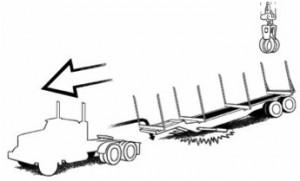BACKGROUND: On a spring day in the Southeast, a log truck unloaded under an overhead crane at a pulp mill and then traveled empty to a satellite woodyard, where the driver expected his trailer to be loaded.
PERSONAL CHARACTERISTICS: The log truck driver was an independent trucker in his mid to upper 50s. He had been driving a truck for 14 years. His previous safety record is unknown.
UNSAFE ACT & CONDITION: The tractor’s fifth-wheel locking mechanism and the trailer’s kingpin had a rather loose fit—the jaws on the fifth wheel were worn. The driver temporarily dealt with this unsafe condition by chaining the fifth wheel to the trailer.
ACCIDENT: As the driver left the unloading area at the pulp mill and pulled forward, the trailer separated from the tractor and hit the ground. (The driver thought that perhaps the crane had pulled it loose.) The driver asked the crane operator to lift his trailer up so he could back under it, re-attach, and pull away. He then used a chain to secure the fifth wheel to the trailer.
When the driver arrived empty at the satellite woodyard, a woodyard employee noticed that the fifth wheel was chained to the trailer. The employee inspected the truck and trailer connection and noticed that the fifth-wheel jaws were worn and needed to be repaired.
RESPONSE: The woodyard employee told the driver that the facility would not load his truck until he had repaired the damage. All woodyard operators were made aware of this “problem truck” and reminded of the company’s policy never to load an unsafe truck. The driver returned to the satellite woodyard a day or two later with the “problem” fifth wheel replaced. He thanked the woodyard personnel for keeping him safety-conscious.
RECOMMENDATIONS FOR CORRECTION: Truck drivers should perform daily inspections of their tractor-trailers, and they should repair or replace unsafe equipment before operation. Learning to spot potential equipment failures and problems ahead of time can save lives.
The pre-trip inspection of the fifth wheel coupling area should include the following:
- Make sure the lower fifth wheel is securely mounted to the frame and that there are no welds, cracks, or missing/damaged bolts.
- Make sure there is enough grease on the fifth wheel.
- Ensure there is no visible space between the upper fifth-wheel plate (on trailer) and the lower fifth wheel (on tractor).
- Make sure the locking jaws are fastened around the shank of the kingpin and not its head.
- Make sure the release arm is properly seated and the safety latch/lock is engaged.
- Make sure the kingpin is not damaged.
- Ensure that the apron is securely mounted to the trailer frame and is not bent, cracked, or broken.
- Never attempt to drive a damaged or unsafe tractor or trailer. Fix the problem before returning to a public highway.
Scalehouse and other woodyard personnel can enhance truck safety by notifying the driver if they spot any safety problems when loading or unloading trucks. In this incident, the woodyard’s refusal to do business with this truck driver until he had fixed his safety problem may have prevented a serious injury or fatality.
 Courtesy of the Forest Resources Association: https://www.forestresources.org/
Courtesy of the Forest Resources Association: https://www.forestresources.org/
